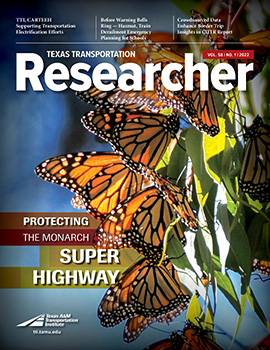
In this issue of the Texas Transportation Researcher, we’ve featured TTI experts conducting cutting-edge research designed to preserve and protect our environment. That includes helping pave the way for alternative-fueled vehicles, like electric cars. Electrified and fuel-celled propulsion are gaining significant momentum, but internal combustion engines (ICEs) aren’t an extinct species yet.
It’s easy to get excited about cleaner energy sources. Climate change accelerated by carbon-heavy emissions, including from ICE vehicles, is an existential threat. Reducing that carbon load is a top priority, so it’s easy to get excited about alternative-fueled vehicles. Major automobile manufacturers like Ford, GM, Volvo and Mercedes have committed to producing scores of electrified models by 2030. But right now, NPR reports, approximately 97 percent of vehicles are gas and diesel fueled. And, according to Statista.com, U.S. gas stations recorded more than $100 billion in sales in 2020. That ship can’t turn quickly, no matter how enthusiastic we are about saving the planet.
Political pressures, public affordability, fleet turnover rates, infrastructure needs — these are just some of the challenges to shifting to cleaner propulsion vehicles. They’ll titrate into the marketplace as price points, technology, public acceptance and policy incentives combine to catalyze change. In the meantime, we must be vigilant in pursuing carbon-reduction strategies that yield cleaner emissions produced by ICE vehicles.

The trucking industry provides a window into the complexities of transitioning the fleet. Freight carriers operate on thin profit margins. A recent Bloomberg Law article suggests that by 2030 — due to the weight of the massive batteries powering them — long-haul electric trucks could be 5,000+ pounds heavier than ICE trucks. That means about 6 percent of the 80,000-pound weight limit imposed on trucks by law would be used by batteries. That’s 6 percent less cargo revenue the industry will need to make up somewhere else in its business model to maintain viability. Trucking sub cultures like long-distance hauls versus last-mile deliveries (think: those blue Amazon vans in your neighborhood) further complicate the industry’s evolutionary landscape.
We saw a similar reality check in recent years regarding connected and automated vehicles. Not long ago, headlines had us riding in self-driving cars as a matter of course by 2025. It turned out to be much more complicated than we thought to make such a fundamental shift from person-controlled to computer-controlled driving.
Let’s apply that lesson here. While we must continue to facilitate the shift to cleaner propulsion vehicles, let’s be realistic about how long that will take. In the meantime, what can we do to reduce the environmental impact of the internal combustion engine? For the foreseeable future, we’ll continue to rely on our ICE vehicles while the transition to electric vehicles is underway.
